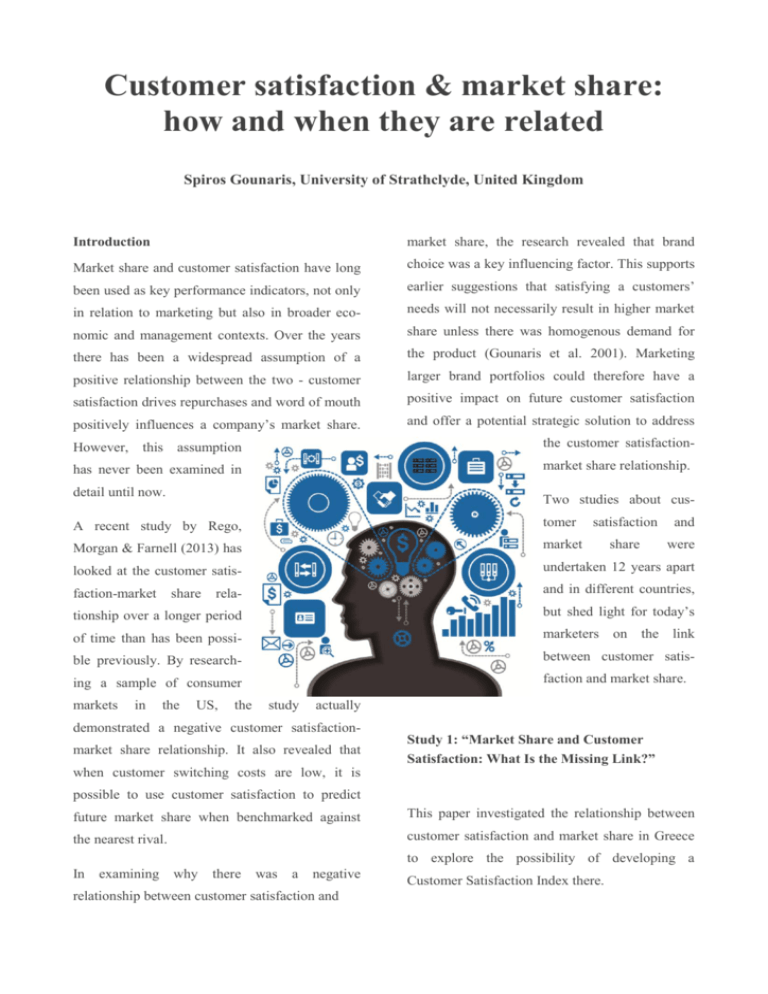
Customer satisfaction & market share:
how and when they are related
Spiros Gounaris, University of Strathclyde, United Kingdom
Introduction
market share, the research revealed that brand
Market share and customer satisfaction have long
choice was a key influencing factor. This supports
been used as key performance indicators, not only
earlier suggestions that satisfying a customers’
in relation to marketing but also in broader eco-
needs will not necessarily result in higher market
nomic and management contexts. Over the years
share unless there was homogenous demand for
there has been a widespread assumption of a
the product (Gounaris et al. 2001). Marketing
positive relationship between the two - customer
larger brand portfolios could therefore have a
satisfaction drives repurchases and word of mouth
positive impact on future customer satisfaction
positively influences a company’s market share.
and offer a potential strategic solution to address
However, this assumption
the customer satisfaction-
has never been examined in
market share relationship.
detail until now.
Two studies about cus-
A recent study by Rego,
tomer
satisfaction
and
Morgan & Farnell (2013) has
market
share
were
looked at the customer satis-
undertaken 12 years apart
faction-market
rela-
and in different countries,
tionship over a longer period
but shed light for today’s
of time than has been possi-
marketers on the link
ble previously. By research-
between customer satis-
ing a sample of consumer
faction and market share.
markets
in
share
the
US,
the
study
actually
demonstrated a negative customer satisfactionmarket share relationship. It also revealed that
Study 1: “Market Share and Customer
Satisfaction: What Is the Missing Link?”
when customer switching costs are low, it is
possible to use customer satisfaction to predict
future market share when benchmarked against
This paper investigated the relationship between
the nearest rival.
customer satisfaction and market share in Greece
to explore the possibility of developing a
In
examining why
there
was
a
negative
relationship between customer satisfaction and
Customer Satisfaction Index there.
The consumer goods sector was selected as the
them as well as the negative relationship that
basis of this study, namely bottled mineral water
previous analyses had suggested.
(an industry with high homogeneity of demand)
The data from this study came from The National
and “oyzo” (a traditional Greek aperitif with high
Quality Research Center at the University of
heterogeneity of demand). Consumers were
Michigan's Ross School of Business, which
contacted randomly and 300 responses were
consisted of American Customer Satisfaction
collected.
Index data for approximately 200 companies from
Analysis of the results showed that in the
1994-2006.
homogeneous market of bottled mineral water, the
market
leader
enjoyed
significantly
Analysis revealed that, when compared with a
higher
nearest rival, current customer satisfaction was
customer satisfaction levels. By contrast, when
positively associated with future market share
the data from the heterogeneous market was
whilst current market share was negatively
considered, the relationship between market share
associated with future customer satisfaction.
and customer satisfaction was uncertain. This was
because more or less the same levels of overall
What is more, the higher the customer switching
satisfaction were reported regardless of position in
cost, the weaker the positive effect of customer
the market. Further analysis also revealed that the
satisfaction on future market share. This means
market leader didn’t always enjoy the highest
that heterogeneity in a firm's customer base
customer satisfaction levels and, as the level of
mediates
customer satisfaction decreased, so did the
current
manufacturer’s market share.
satisfaction. In turn, the number of brands
the
negative
market
share
relationship
and
future
between
customer
marketed by a firm is mediated by preference
In other words, users of the leading brand are not
heterogeneity in the market share-future customer
necessarily satisfied either with the product itself
satisfaction relationship.
or any other element of the company’s marketing
mix. For example, in this case the brand ranking
4th for market share enjoyed higher levels of
Application today
customer satisfaction.
Despite the economic and cultural differences
between the US and Greece, these studies have
Study 2: “Re-examining the Market Share Customer Satisfaction Relationship”
produced a very similar picture of how customer
satisfaction relates to market share.
This study investigated the relationship between
The link between the two is strong provided there
market share and customer satisfaction but over a
is homogeneity in the nature of the demand and
period of time. The aim was to establish the
the consumers’ preferences for a given industry.
effects of time on both, whilst seeking to
The modern day marketing manager therefore
understand the nature of the relationship between
needs to evaluate the nature of demand for the
2
customers
they
target
in
satisfaction and maintain a valuable proposition.
more
Alongside this, it is essential to carry out market
disparate their tastes and preferences the lower the
research to monitor rivals and evaluate the
impact of customer satisfaction on the company’s
customer’s perception of switching costs as well
market share.
what drives buying behaviour and repatronage.
Managers facing increased levels of heterogeneity
In most cases, the benefit of investing in
in their customer’s tastes and preferences need to
systematic research will outweigh the cost and
investigate just what their customers draw value
become invaluable in steering a company’s efforts
from. Only then can they rebalance customer
to improve customer satisfaction.
improving customer
before
investing
satisfaction. The
Professor Spiros Gounaris
Marketing Professor at the University of Strathclyde, United Kingdom
The full references for this study:
Gounaris S., Avlonitis G., Kouremenos A., Papavasiliou N. and Papastathopoulou P. (2002), “Market Share and
Customer Satisfaction: What Is the Missing Link?”, Journal of Euromarketing, Vol. 10 No4, pp. 61-81
Rego L.L., Morgan N.A., & Fornell C. (2013) “Reexamining the Market Share - Customer Satisfaction Relationship”
Journal of Marketing, Vol. 77 No4, pp. 1-20
Copyright (c) 2013
Article produced by the Academic Group of the European Marketing Confederation (EMC). All rights reserved
Editor; Hannah McGivern
Images from Shutterstock.com Central Image Copyright; Vladgrin







